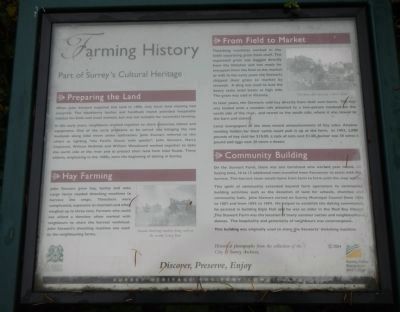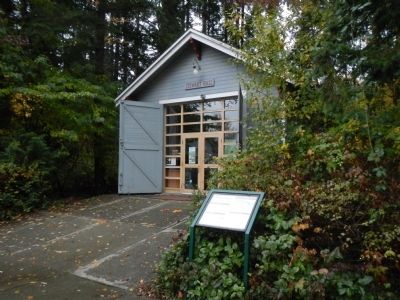Surrey in Greater Vancouver, British Columbia — Canada’s West Coast (North America)
Farming History
Part of Surrey’s Cultural Heritage
Inscription.
Preparing the Land
When John Stewart acquired this land in 1880, only basic land clearing had occurred. The blackberry bushes and hardhack marsh provided hospitable habitat for birds and small animals, but was not suitable for successful farming.
In the early years, neighbours worked together to share resources, labour and equipment. One of the early problems to be solved was bringing the rich lowlands along tidal rivers under cultivation. John Stewart referred to this effort as fighting “the Pacific Ocean with spades”. John Stewart, Harry Chantrell, William McBride and William Woodward worked together to dyke the north side of the river and to protect their land from tidal floods. These efforts, originating in the 1880s, were the beginning of dyking in Surrey.
Hay Farming
John Stewart grew hay, barley and oats. Large farms needed threshing machines to harvest the crops. Threshers were complicated, expensive to maintain and often weighed up to three tons. Farmers who could not afford a thresher often worked with neighbours to share the harvest workload. John Stewart’s threshing machine was used by the neighbouring farms.
From Field to Market
Threshing machines worked in the fields separating grain from chaff. The separated grain was bagged directly from the thresher and was ready for transport from the field to the market or mill. In the early years the Stewarts shipped their grain to market by steamer. A sling was used to load the heavy sacks onto boats at high tide. The grain was sold in Victoria.
In later years, the Stewarts sold hay directly from their own barns. The hay was loaded onto a wooden raft attached to a two-person rowboat on the north side of the river, and rowed to the south side, where it was towed to the barn and stored.
Local newspapers of the time record announcements of hay sales. Anyone needing fodder for their cattle could pick up it up at the farm. In 1903, 2,000 pounds of hay sold for $10.00, a sack of oats cost $1.08, butter was 30 cents a pound and eggs cost 20 cents a dozen.
Community Building
On the Stewart Farm, there was one farmhand who worked year round. At haying time, 10 to 15 additional men travelled from Vancouver to assist with the harvest. This harvest team would move from farm to farm until the crop was in.
This spirit of community extended beyond farm operations to community building activities such as the donation of land for schools, churches and community halls. John Stewart served on Surrey Municipal Council from 1884 to 1887 and from 1892 to 1894. He helped to establish the dyking commission, he assisted in building Elgin Hall and
he was an elder in the Mud Bay Church. The Stewart Farm was the location of many summer socials and neighbourhood dances. The hospitality and generosity of neighbours was commonplace.
This building was originally used to store the Stewarts’ threshing machine.
Erected 2004 by Surrey Parks, Recreation & Culture.
Topics. This historical marker is listed in this topic list: Agriculture. A significant historical year for this entry is 1880.
Location. 49° 3.887′ N, 122° 50.533′ W. Marker is in Surrey, British Columbia, in Greater Vancouver. Marker can be reached from Crescent Road. This marker is on the grounds of the Historic Stewart Farm. Touch for map. Marker is at or near this postal address: 13723 Crescent Road, Surrey BC V4P 1J4, Canada. Touch for directions.
Other nearby markers. At least 8 other markers are within 16 kilometers of this marker, measured as the crow flies. Historic Stewart Farmhouse (a few steps from this marker); Historic Elgin (approx. 1.1 kilometers away); Historic Port Elgin (approx. 1.3 kilometers away); The Semiahmoo Trail (approx. 1.3 kilometers away); Historic McMillan Expedition (approx. 3.4 kilometers away); Peace Arch (approx. 9.4 kilometers away); Salmon! (approx. 13.6 kilometers away); The New Westminster Court House and Land Registry Office (approx. 16.2 kilometers away). Touch for a list and map of all markers in Surrey.
Credits. This page was last revised on June 16, 2016. It was originally submitted on November 12, 2012, by Barry Swackhamer of Brentwood, California. This page has been viewed 542 times since then and 8 times this year. Photos: 1, 2. submitted on November 12, 2012, by Barry Swackhamer of Brentwood, California. • Syd Whittle was the editor who published this page.

